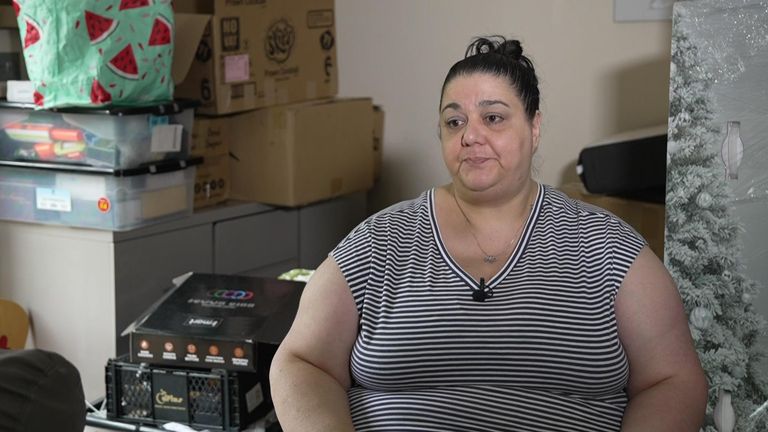Mortgage payers are now in the minority in the UK.
Data from the census reveals that there are more people renting, and more people owning their homes outright, than there are people still paying off their mortgage.
Within the EU just three countries – Germany, Austria and Denmark – have more renters as a share of their population than there are in the UK.
Interest rates have risen from 0.1% to 5% in the last 18 months, and a Bank of England announcement on Thursday is expected to see rates rise higher still.
Many mortgage payers – those paying variable rates or whose fixed deals have expired – have either been hit with significant rises to their monthly payments or been forced to extend terms, meaning they are paying off the loan more slowly.
And there’s more pain still to come, sharply perhaps in coming months – there was a big spike of mortgages arranged before the pandemic-era stamp duty holiday ended – any of those deals that had a two-year fix will be coming to a close around now.
But it’s not just mortgage payers who are exposed to those rises, renters are vulnerable too.
And they are typically in a worse place to start off with, spending more of their income on housing costs as a percentage – 33% on average (42% in London), compared with 22% for mortgage payers.
They are also more likely to live in non-decent standard homes, have lower savings, and lower incomes overall.
What’s happening with renters?
Research by Zoopla estimates that around 60% of rented properties are mortgaged, with most of those on interest only mortgages, meaning they are particularly exposed to rate changes.
For the two in five Britons who are renters, a rise in monthly repayments is nothing new. Many landlords raise rent each year, to keep up with inflation or market demand, even when mortgage repayments were staying relatively low.
Now however, those landlords whose repayments are going up could be forced to raise rents by more to ensure they aren’t losing money month on month.
That’s what happened to Andi Michalakis, a 51-year-old in Stevenage who lives in a three-bed house, currently surrounded by boxes containing her belongings, along with her 14-year-old son.
Andi says her landlord doesn’t have a job, but lets out multiple properties that he owns and has a mortgage on the one she’s been living in for the past nine years.
Through the time she’s been there her rent has typically risen by a manageable £25 a month each year. Andi explains that she would carry out maintenance like painting, fixing taps and work in the garden out of her own pocket rather than at the expense of the landlord. She has never missed a rent payment.
During the pandemic there was no change to her rent, but at the beginning of 2022 it went up by £75 a month, to £1,200. Less than a year later her landlord asked for £1,300, which was too much to afford – particularly as Andi’s work-life and health had changed during the pandemic.
Andi had to stop working for a time due to illness, and her work in the fashion industry was affected by lockdown, meaning that £100 extra her landlord was asking for represented almost half of all that she had left after paying the rent.
Andi’s family had already been helping out with shopping – her sister would bring food while her brother would come through with toiletries and other essentials.
She spoke to the council to explore her options in resisting the further £100 increase – they told her that the landlord was now asking for £1,425 instead – a 19% increase on the £1,200 she was paying before.
Soon after, he issued a Section 21 “no fault” eviction notice, starting the process of removing Andi from the place she had made her home for the past decade.
Sky News tried to contact Andi’s landlord, via the estate agent and through the council, but he was unavailable to comment. The estate agent said they would not have asked for a rent increase as high as £225, because it was too much of a jump in one hit.
More than 30,000 people have reached out to homelessness prevention support after being issued Section 21 notices since the start of January 2022, with the number rising more recently. Many people, like Andi, can’t pass affordability tests on new rentals after being evicted, despite perfect records of paying rent on time historically.
Avoiding homelessness
Andi’s biggest fear at the moment is that she ends up homeless, in inappropriate temporary accommodation, potentially sharing a room with her teenage son, and is forced to stay there for years until she gets to the top of the priority list for housing.
She has been warned that temporary accommodation may not even be in Stevenage where her son goes to school.
“He’s a teenage boy, he needs his own space to do the things he likes. I’ve heard of cases of people stuck like that for years. Who wants to be locked in one room like that with their mother?”
Jasmine Basran, Head of Policy and Campaigns at homeless charity Crisis, told Sky News that competition in the private rental sector is making things particularly difficult for those worst off.
“With what’s happening with mortgages, everyone’s turning to the private rented sector and therefore, landlords have choice.
“Often it’s people on the lowest incomes who get turned away from properties because a landlord can find someone else who’s willing to let the property who they feel is more secure or who can cover a higher cost of rent.”
Mortgage holders
Although mortgage holders are being squeezed at the moment, they are in a comparatively comfortable spot. The majority will have equity in the house or other savings to fall back on, and higher average earnings in general.
Depending on how far along you are with repaying your mortgage, servicing the interest may be a relatively small contribution. The rate that fully owned properties have been increasing recently suggests that there will be large groups more people with small amounts left to pay, who will become full owners in the coming years.
Mortgage holders are also empowered to negotiate lower monthly repayments with banks who have committed to support them and find solutions that avoid repossessions, in a way that renters often can’t with their landlords.
UK Finance, a banking and finance research group, estimates that around 7,000 mortgage holders will have their homes repossessed this year, far fewer than that number seeking homelessness support after being served Section 21 notices. After the 2008 financial crash 40,000 homes were repossessed.
James Tatch, Head of Analytics at UK Finance, said: “Mortgage holders came into this in a really strong place in general, because mortgage arrears are at historic lows. That’s thanks partly to the ultra-low rates we’ve had in recent years, as well as more responsible lending, and the savings many households built up during COVID.
“In that situation, lenders will work with every borrower to work out the best solution to their specific situation. That might be a reduction of the mortgage for a certain amount of time, or a change to paying interest only.”
Competition in the rental market
One of the reasons that evictions from private rental can lead towards homelessness is the competition in the rental market.
“We are starting to see a big increase in people needing help and ending up in temporary accommodation because there’s nowhere else for them to go,” said Ms Barsan.
There are five people competing over every room advertised in house and flat shares on SpareRoom, while Rightmove report a 42% increase in demand for rental properties from 2019 to 2023.
This squeeze has been driven by both an increase in renters seeking rooms as well as a reduction in the number of rooms available, with data from SpareRoom showing an additional 69,000 renters competing over 27,000 fewer rooms compared to 2017.
Some areas in England have experienced faster rent increases than others – a small handful have even seen reductions. The map below shows change in rents by area, for the lower end of the market (the cheapest 25%) and for the middle of the market (average rents).
In Middlesbrough, those cheaper rents have increased by 15.4%, from £390 to £450. That would have been the middle of the market last year, now it’s among the cheapest you can find.
Rents for newly advertised properties have increased even faster than for those in existing tenancies, perhaps explaining a motivation for landlords to remove long-standing tenants.
The average price of rental properties advertised on Rightmove in the UK increased by 10.2%, from £1,283 to £1,413 in the year to June. Prices for rooms in house and flat shares advertised on SpareRoom are 14.5% higher than a year ago across the UK on average, up from £678 to £776 a month in July this year.
Social housing
The current waiting list for social housing stands at 1.2 million. With sell-offs and demolitions, many local authorities end up with a net loss of social housing year-on-year, despite a rising population.
Because of this lack of capacity, the most vulnerable homeless households are prioritised for social housing, while others are moved into temporary accommodation.
Despite being disabled and having a teenage child, Andi is in priority Band D, the fourth lowest. Those in Band A are often seeking refuge from domestic violence, for example.
This means she often misses out on offers of suitable housing and is left with options she has to decline because of her mobility issues.
The number of households living in temporary accommodation now stands at its highest since records began in 1998.
What can be done to solve the housing crisis?
Crisis say that there are things that the government can do right now to ease the housing crisis.
“The other side of temporary accommodation, apart from the very human cost of what people are having to go through by living there, is that it has a phenomenal financial cost to local authorities,” says Ms Basran.
Councils spent at least £1.6 billion on temporary accommodation in the latest year, according to the government’s own analysis.
“That’s a huge amount of money to manage people in homelessness. And that money could be used to support people into long term housing, if we had a clear plan of delivery, and unfreeze housing benefit so that more properties are affordable to people.”
A spokesperson from the Department for Levelling up, Housing and Communities said: “Our landmark Renters (Reform) Bill will deliver a fairer deal for both renters and landlords. We are abolishing section 21 ‘no fault’ evictions to give tenants greater security in their homes.
“We are also improving availability of social housing. Our Levelling Up White Paper committed to increasing the supply of social rented homes, and many of the new homes delivered through our Affordable Homes Programme will be for social rent.
“We are on track to deliver 1 million new homes in this parliament, and we are investing £11.5 billion to build more of the affordable, quality homes this country needs.”
The Data and Forensics team is a multi-skilled unit dedicated to providing transparent journalism from Sky News. We gather, analyse and visualise data to tell data-driven stories. We combine traditional reporting skills with advanced analysis of satellite images, social media and other open source information. Through multimedia storytelling we aim to better explain the world while also showing how our journalism is done.


